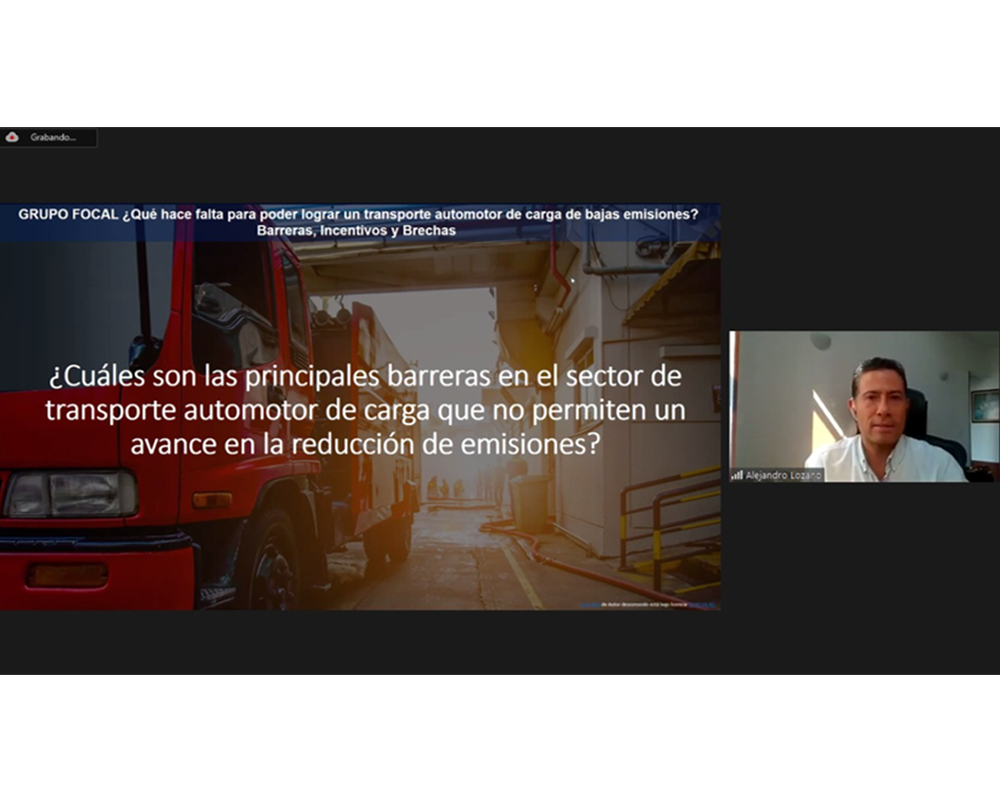

17 Nov 2021
The Giro Zero project carried out its first focus group to identify the barriers to reducing carbon emissions in Road Freight Transport (RFT). The aim was to learn about the actions that have been implemented in both the private and public sectors to contribute towards the decarbonization of transport.
17 representatives from local and national government entities, transport and load-generating companies, and vehicle manufacturers participated in the focus group to answer the question: What does it take to achieve low-emission road freight transportation?
What the focus group participants had to say
"New technologies are good for those who have the resources to invest in them, but small transporters cannot change from a vehicle worth 200 million to one that costs 400 million."
Juan Flórez, small owner of cargo transport vehicles.
“We are the largest cargo fleet in the country. We had negotiated the acquisition of a gas fleet, but the plans were stopped by the pandemic. However, we bought a new Kenworth flee, with 2020 and 2021 models, which is more environmentally friendly. We have also trained the 1,300 drivers we have in technical aspects of driving that influence the reduction of emissions and we also measure the carbon footprint ”.
Iván Andrés Herrera, Environmental Engineer at Coltanques.
"To reduce emissions, all sectors (fuel producers, load generators, transporters) must work together to reach the ultimate goal - that you cannot be hired if you are not reducing emissions.
Juan Manuel Cubides, Legal Vice President at Inter Rapidísimo.
"We get used to looking at things in the same way and it’s often thought that innovation can only be technological, but it can also be done through business models. Technology may be available and I believe that markets are open to financial incentives".
Alejandro Lozano Rojas, Marketing and Innovation Manager at Expocafé.
“We have four natural gas tractors with capacity for 35 tons of cargo and long distances. Due to its highly complex geography, these vehicles do not work on routes in Antioquia, but they do work very well for us on the coast and even in the central area of the country ”.
Sustainability Analyst at a company leasing transport vehicles.
“At Colfecar we have seen that although one of the difficulties is economics, the technological process in Colombia is also a big limitation, as previously mentioned. The information and knowledge that our affiliates have is very low (e.g. the benefits offered by the government). This should be more widely known and understood”.
Sara Caicedo, Economic Analyst at Colfecar.
“We have the task to materialize the possibilities for the massification of low and zero-emission vehicles based on public policies that are still not widely used. There is a lack of infrastructure, policies that encourage more this type of technologies and, moreover, the price and possibilities of implementing them en masse. The big starting point is that electric vehicles need to have much bigger economic incentives than those of hybrids and, in that order, bigger than those of gas vehicles and conventional combustion vehicles”.
Juliana Rico, executive director of the Chamber of the Industria Automotriz of the ANDI.
“The Ministry of Transport's modernization program needs a technological update. For example, for the renovation of large-capacity vehicles, we offer an economic recognition of up to 60% for conventional technologies, such as diesel, and 70% for the import of low and zero-emission vehicles. Additionally, for those who own no more than 2 cargo vehicles we have an IVA* exemption”.
Julián Soto, Advisor to the Vice Ministry of Transport.
*Value-added tax (VAT)
“We set up a sustainable transport table with the Ministry of Energy, the Ministry of Transport, the Ministry of the Environment, the Mining and Energy Planning Unit and DNP to coordinate and articulate the efforts that are carried out to promote not only electric mobility, but also other energy transition and achieve those objectives: to not only reduce Greenhouse Gases, but also improve public health, energy efficiency and competitiveness of the country.”
Óscar Cuéllar, Advisor to the Director of Sustainable Energy and Transport Infrastructure of the National Planning Department (DNP).
The incentives are still unknown
During the discussion and exchange of ideas, attendees took part in a short survey. Firstly, they were asked “how expensive is it to reduce emissions in the RFT sector?”. 63% of participants believed that the cost of reducing emissions was ‘High’ and 37% thought it was ‘Medium’.
When asked “how accessible are low-emission technologies in cargo transportation in Colombia?”, 50% answered that access to clean technologies is ‘Low’; 39% that it is ‘Medium’ and 11% that it is ‘High’.
The last question, “do you know the government incentives for scrapping trucks and adopting clean technologies?” saw half of the attendees answer ‘No’ and half answer ‘Yes’.